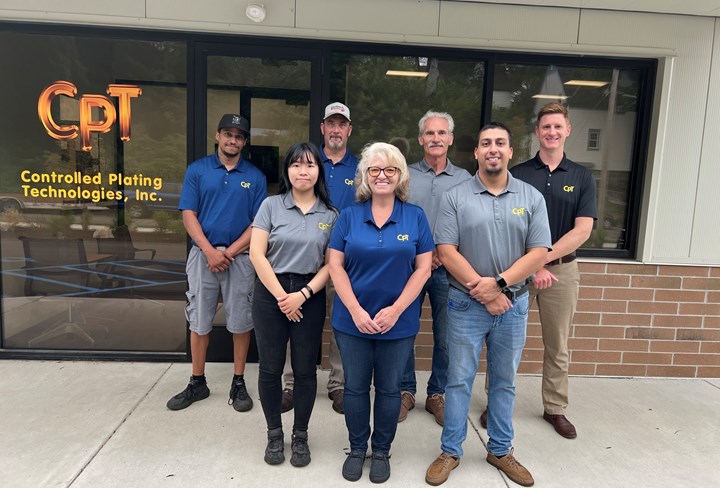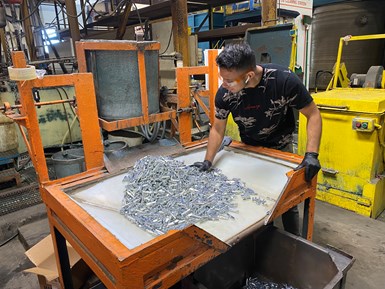
The management team at CPT: (Front Row, left to right) Bo Ah Jung, quality manager; Cindy Pierce, controller; Cesar Olivas, production manager; (Back Row, left to right) Paul Burt, shipping manager; Aaron Wiersum, maintenance manager; Steve Slot, president; Douglas Slot, general manager.
Photo Credit: All photos courtesy of Controlled Plating Technologies Inc.
Controlled Plating Technologies Inc. (CPT) is a family-owned finishing operation with an eye on growth. The company was founded in 1991 and specializes in alkaline zinc and zinc alloys. CPT’s 42,000 sq. ft. facility is located near downtown Grand Rapids, Michigan. The company recently completed a big addition to its facility, expanding its warehouse and office space as part of a focus on growth in the future. Products Finishing recently sat down with general manager, Douglas Slot, to learn more about the company’s current operation and recent expansion.
Give us some background about CPT. How did the company get its start and how has it grown into what it is today?
CPT was founded in 1991 by three partners Herman Segal, Dick Hakim and John VanderPloeg, who all had backgrounds in the plating industry. The three set up a zinc plating operation in what had been a copper, nickel, chrome shop, which they operated until about 2000 when my father, Steve Slot, became a partner. In 2004, my dad became the sole owner.
CPT has been offering zinc and zinc alloys since the 1990s. We were an early adopter of trivalent passivates for the yellow and the black. We did our last load of hexavalent in 2012 — and that was black because that was hard to match the appearance. We worked closely with Dipsol of America (Livonia, Mich.) to fine-tune our process for trivalent black and were finally able to replace the hexavalent bath.
I started working here in 2003 — at the time it was a high school job, and it turned into a career.
What markets do you typically serve?
Our largest market is automotive — it accounts for probably 70% of our business. We also do a lot of agriculture, as well as construction and heavy equipment, medical, and a bit of military.

CPT offers clear yellow and black, zinc and zinc-iron, on its Cyclemaster supplied by Fanta Equipment Co. (Cleveland, Ohio).
What are CPT’s current capabilities?
The majority of our business is rack plating. We do rack zinc and zinc-iron. We have two rack lines, one is manually operated with a 10 foot flight bar with 42" height and 16" direction of travel — so it’s a pretty big line. On the manual line, we offer clear yellow and black, zinc and zinc-iron. We have a Fanta Cyclemaster that’s a 16-inch rack width by 45 inches high — it’s a single process machine. On our 16"x36" barrel line, we offer clear yellow and black zinc, zinc-iron, and zinc-nickel. Everything we do is alkaline electrolyte.

A barrel line operator, Eric Calderon, is scanning the barrel-plated parts for defects before loading them into the finished tub.
Can you talk about the team and work environment at CPT?
We have a staff of about 50 employees and we are fully staffed currently. We’ve had to get creative with compensation and adjust quickly in response to the changing labor market to maintain zero open positions over the past couple of years.
It can be hard to find experienced people in this industry, so we’ve had to grow our own. We’re continuously updating our training program to include not only how to do the job, but why it’s important.
Over the past five years, most of our management team retired, so Steve and I had to find successors. We’re really excited about the current team and where we’re going as a company.
You recently completed a large expansion of your facility. What prompted the expansion and what are the new additions?
We ran out of space. Our capacity was limited by the number of parts — both finished and unplated — that we could hold. We didn’t have much warehouse space and talked about it for about five years. We tried storing parts in semi-trailers and even shuttling parts to and from an off-site warehouse. We pulled the trigger in late 2020 and added 12,000 square feet of warehouse space, new shipping and receiving and new offices.
It has enabled us to produce more parts without all the congestion. We have about 9,000 active parts, so it takes quite a bit of room, and the new warehouse is strictly for storage at this point.
Let’s talk about industry trends and your approach — how do you think this sets you up for future business and growth, particularly with changes in the automotive sector and the growing market for electric vehicles and hybrids?
Our chemical supplier, Columbia Chemical, has advised us that tin zinc will likely be growing demand for some of those applications. We’re also looking into cobalt-free passivation for heath, environmental, and, as of recently, cost reasons. We’re always willing to cater to what our customers need, and this additional space opens up the ability to add new lines in the older parts of the facility.
We’ve done that before. In 2012, BroCo Products introduced us to a customer with a large volume of work and that led to the installation of our Cyclemaster. Initially we installed the line specifically for their parts. That’s something we’re always willing to do if a customer says, “Hey, I’ve got a huge amount of parts that we need plated. Can you work with us?” As our plant manager used to say, “we’re always looking for a new best customer.”
Related Content
How to Choose Between Sulfate and Chloride-Based Trivalent Chromium
There are several factors to consider when choosing between sulfate and chloride-based baths for trivalent chromium plating. Mark Schario of Columbia Chemical discusses the differences and what platers should keep in mind when evaluating options.
Read MoreTrivalent Chrome Overview
As the finishing industry begins to move away from the use of hexavalent chromium to trivalent chromium, what factors should finishers consider as they make new investments? Mark Schario, chief technology officer for Columbia Chemical offers a helpful overview of this complicated topic.
Read MoreLiquid Chrome Vs. Chromic Acid Flake
Contemplating how to continue offering chromic acid services in an increasingly stringent regulatory world? Liquid chrome products may be the solution you’re looking for.
Read MoreAdvantages to Pumped Eductor Agitation
Not all agitation methods are created equally. Pumped agitation with eductor nozzles can improve process tanks and quickly show a reduction in operating costs while keeping staff safe, following environmental legislation and preventing pollution.
Read MoreRead Next
Delivering Increased Benefits to Greenhouse Films
Baystar's Borstar technology is helping customers deliver better, more reliable production methods to greenhouse agriculture.
Read MoreEducation Bringing Cleaning to Machining
Debuting new speakers and cleaning technology content during this half-day workshop co-located with IMTS 2024.
Read MoreEpisode 45: An Interview with Chandler Mancuso, MacDermid Envio Solutions
Chandler Mancuso, technical director with MacDermid Envio discusses updating your wastewater treatment system and implementing materials recycling solutions to increase efficiencies, control costs and reduce environmental impact.
Read More























